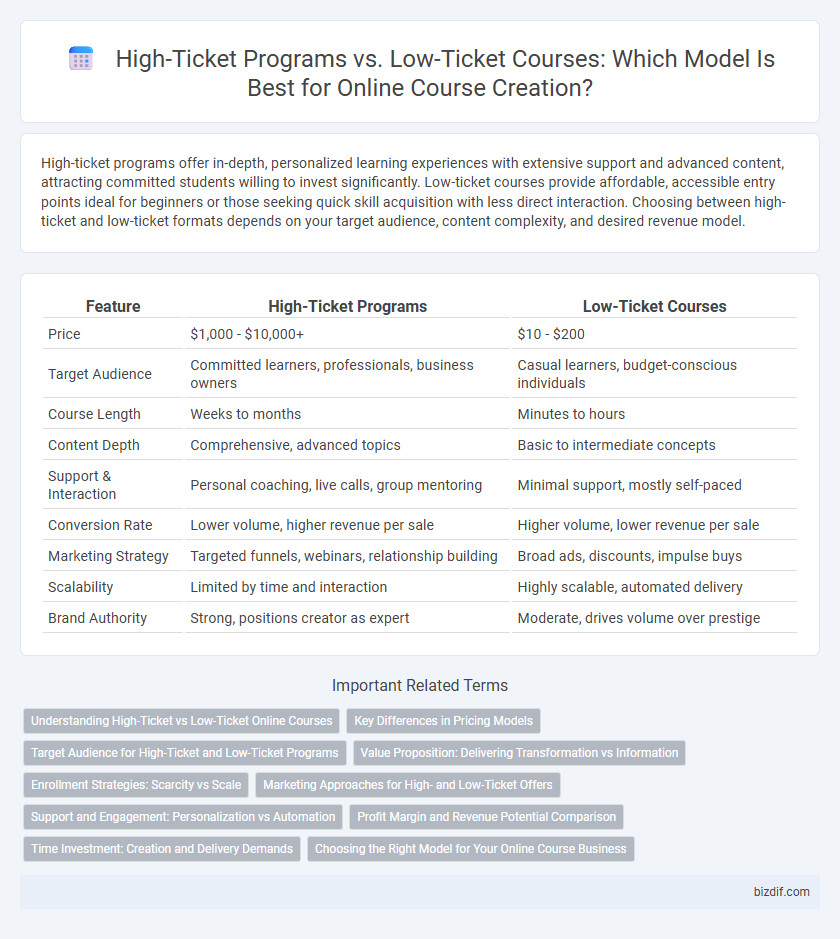High-ticket programs offer in-depth, personalized learning experiences with extensive support and advanced content, attracting committed students willing to invest significantly. Low-ticket courses provide affordable, accessible entry points ideal for beginners or those seeking quick skill acquisition with less direct interaction. Choosing between high-ticket and low-ticket formats depends on your target audience, content complexity, and desired revenue model.
Table of Comparison
| Feature | High-Ticket Programs | Low-Ticket Courses |
|---|---|---|
| Price | $1,000 - $10,000+ | $10 - $200 |
| Target Audience | Committed learners, professionals, business owners | Casual learners, budget-conscious individuals |
| Course Length | Weeks to months | Minutes to hours |
| Content Depth | Comprehensive, advanced topics | Basic to intermediate concepts |
| Support & Interaction | Personal coaching, live calls, group mentoring | Minimal support, mostly self-paced |
| Conversion Rate | Lower volume, higher revenue per sale | Higher volume, lower revenue per sale |
| Marketing Strategy | Targeted funnels, webinars, relationship building | Broad ads, discounts, impulse buys |
| Scalability | Limited by time and interaction | Highly scalable, automated delivery |
| Brand Authority | Strong, positions creator as expert | Moderate, drives volume over prestige |
Understanding High-Ticket vs Low-Ticket Online Courses
High-ticket online courses typically range from $1,000 to $10,000 or more, offering in-depth content, personalized coaching, and exclusive resources, appealing to learners seeking comprehensive skill mastery. Low-ticket courses, generally priced under $200, provide foundational knowledge or specific skill training, catering to a broader audience with budget-friendly options. Understanding these distinctions helps course creators tailor marketing strategies, course design, and customer support to match the expectations and commitment levels of their target audience.
Key Differences in Pricing Models
High-ticket programs typically range from $1,000 to $10,000 or more, offering in-depth content, personalized coaching, and extensive support, while low-ticket courses usually cost under $500 and focus on delivering condensed, self-paced learning. The pricing model of high-ticket programs emphasizes value through exclusive access and transformation, justifying higher costs, whereas low-ticket courses rely on volume and accessibility to attract a broader audience. Choosing the right model depends on target market willingness to invest, desired revenue goals, and the level of engagement the course creator can provide.
Target Audience for High-Ticket and Low-Ticket Programs
High-ticket programs target professionals or entrepreneurs seeking in-depth, personalized training with significant investment capacity, often emphasizing transformation and exclusive access. Low-ticket courses appeal to beginners or budget-conscious learners looking for foundational knowledge or quick skill acquisition at an affordable price point. Understanding audience demographics, motivation, and purchasing behavior is crucial for effectively positioning these course types in the online education market.
Value Proposition: Delivering Transformation vs Information
High-ticket programs maximize client transformation by offering personalized coaching, in-depth modules, and ongoing support that fosters lasting change. Low-ticket courses primarily deliver information through pre-recorded videos or basic content with limited interaction. Emphasizing transformation in high-ticket offerings justifies premium pricing by addressing deeper client needs and ensuring measurable results.
Enrollment Strategies: Scarcity vs Scale
High-ticket programs leverage scarcity by limiting enrollment to create exclusivity and justify premium pricing, resulting in higher per-customer revenue. Low-ticket courses emphasize scale, attracting a larger volume of students through accessible pricing and automated sales funnels, maximizing total enrollment. Effective strategies balance urgency-driven scarcity tactics for high-ticket offers with broad reach and volume-driven marketing to optimize enrollment outcomes.
Marketing Approaches for High- and Low-Ticket Offers
High-ticket programs require personalized marketing strategies that emphasize value, exclusivity, and relationship-building through targeted email campaigns, webinars, and one-on-one consultations. Low-ticket courses benefit from broad-reach tactics like social media ads, influencer partnerships, and automated sales funnels to drive volume and accessibility. Understanding customer intent and purchasing capacity is crucial to tailoring the marketing approach for each offer type effectively.
Support and Engagement: Personalization vs Automation
High-ticket programs emphasize personalized support with tailored coaching and direct interaction to enhance learner engagement, fostering deeper connections and higher retention rates. In contrast, low-ticket courses rely heavily on automation, utilizing pre-recorded content and automated feedback systems that scale efficiently but offer limited individual attention. This distinction impacts how students experience the course and the overall effectiveness of learning outcomes.
Profit Margin and Revenue Potential Comparison
High-ticket programs typically offer higher profit margins due to premium pricing and personalized content, attracting fewer but more invested customers. Low-ticket courses generate higher revenue potential through volume sales, appealing to a broader audience but with lower individual profit margins. Evaluating both models depends on business goals, as high-ticket programs build exclusivity and scalability, while low-ticket courses emphasize accessibility and rapid market penetration.
Time Investment: Creation and Delivery Demands
High-ticket programs demand a significantly higher time investment for both creation and delivery, often involving personalized coaching, live sessions, and extensive support materials. Low-ticket courses generally require less upfront development time and feature automated delivery, allowing for scalable sales with minimal ongoing involvement. Choosing between the two depends on your capacity to maintain engagement and provide value through time-intensive interactions or streamlined automation.
Choosing the Right Model for Your Online Course Business
High-ticket programs generate substantial revenue per enrollment, attracting committed students willing to invest in personalized coaching and in-depth content. Low-ticket courses offer accessibility and volume, appealing to a broader audience with self-paced learning and lower price points. Selecting the right model depends on your target market's budget, desired interaction level, and scaling goals for sustainable online course business growth.
High-ticket programs vs Low-ticket courses Infographic

 bizdif.com
bizdif.com